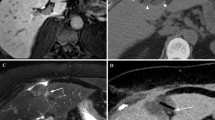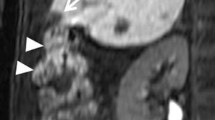Abstract
The purpose of this study was to retrospectively determine the safety and effectiveness of percutaneous cryoablation, monitored with computed tomography (CT) and ultrasonographic (US) guidance, for the treatment of hepatocellular carcinoma (HCC). Four patients with small HCCs underwent one percutaneous cryoablation treatment session monitored with CT and US guidance. All patients underwent pretreatment blood chemistry testing and imaging evaluation. We treated lesions with simultaneous insertion of multiple 17-G cryoprobes (two or three) and defined technical success when the extension of a visible iceball was beyond 5 mm from the tumor margin. Intralesional enhancement or tumoral size increase was defined as local progression compared with that on images obtained immediately after ablation. We evaluated complications and follow-up (at 1, 3, and 6 months). All patients survived without short- or long-term complications. Cryoablation was technically successful in all patients at the end of the procedure. During follow-up two patients developed disease recurrence. One patient developed local tumor progression on the margin of the lesion; the other, a new HCC. In the case of local tumor progression a new elevation of α-fetoprotein (αFP) levels occurred at first follow-up control. In the other case levels of αFP remained stable during the first 3 months after the procedure, then demonstrated a progressive increase in αFP levels beginning at the fourth month, without tumor evidence during CT control at 3 months. We conclude that percutaneous cryotherapy with US guidance and CT monitoring is a feasible, safe, and effective for treatment of HCC. If local ablative procedures of hepatic lesions are to be performed, percutaneous cryoablation, not laparotomic, should be discussed as an alternative therapeutic measure. Longer follow-up should provide proof of the effectiveness of this technique.







Similar content being viewed by others
References
Colombo M, Sangiovanni A (2003) Etiology,natural history and treatment of hepatocellular carcinoma. Antiviral Res 60:145–150
Parkin DM, Bray F, Ferley J et al (2001) Estimating the world cancer burden: Globocan 2000. Int J Cancer 94:153–156
Colombo M, de Franchis R, Del Ninno E et al (1991) Hepatocellular carcinoma in Italian patients with cirrhosis. N Engl J Med 325:675–680
Bolondi L (2003) Screening for hepatocellular carcinoma in cirrhosis. J Hepatol 39:1076–1084
Levin B, Amos C (1995) Therapy for unresectable hepatocellular carcinoma. N Engl J Med 332:1294–1296
Francica G, Marone G (1999) Ultrasound-guided percutaneous treatment of hepatocellular carcinoma by radiofrequency hyperthermia with a “cooled-tip needle.” A preliminary clinical experience. Eur J Ultrasound 9(2):145–153
Raviumar TS (1996) Interstitial therapies for liver tumors. Surg Oncol Clin N Am 5:365–377
Livraghi T, Goldberg SN, Monti F et al (1997) Saline-enhanced radio-frequency tissue ablation in treatment of liver metastases. Radiology 202:205–210
Amin Z, Donald JJ, Masters A et al (1993) Hepatic metastases: interstitial laser photocoagulation with real time US monitoring and dynamic CT evaluation of treatment. Radiology 187:339–347
Yang R, Sanghvi NT, Rescorla FJ et al (1993) Liver cancer ablation with extracorporeal high-intensity focused ultrasound. Eur Urol 23:17–22
Kane RA (1993) Ultrasound-guided hepatic cryosurgery for tumor ablation. Semin Interv Radiol 10:132–142
Atwell TD, Farrell MA, Callstrom MR et al (2007) Percutaneous cryoablation of 40 solid renal tumors with US guidance and CT monitoring: initial experience. Radiology 243:276–283
Weber SM, Lee FT, Warner TF et al (1998) Hepatic cryoablation: US monitoring of extent of necrosis in normal pig liver. Radiology 207:73–77
Tacke J, Adam G, Haage P et al (2001) MR-guided percutaneous cryotherapy of the liver: in vivo evaluation with istologic correlation in a animal model. J Magn Reson Imag 13:50–56
Bruix J, Sherman M, Llovet JM et al (2001) Clinical management of hepatocellular carcinoma. Conclusions of the Barcelona-2000 EASL conference. European Association for the study of the liver. J Hepatol 35:421–430
Sandison GA, Loye MP, Rewcastle JC et al (1998) X-ray CT monitoring of iceball growth and thermal distribution during cryosurgery. Phys Med Biol 43:3309–3324
Lee FT Jr, Chosy SG, Littrup PJ et al (1999) CT monitoring percutaneous in a pig liver model: pilot study. Radiology 211:687–692
Campbell SC, Krishnamurthi V, Chow G et al (1998) Renal cryosurgery: experimental evaluation of treatment parameters. Urology 52:29–33
Chosy SG, Nakada SY, Lee FT Jr et al (1998) Monitoring renal cryosurgery: predictors of tissue necrosis in swine. J Urol 159:1370–1374
Livraghi T (2001) Guidelines for treatment of liver cancer. Eur J Ultrasound 13:167–176
McGahan JP, Dodd GD 3rd (2001) Radiofrequency ablation of the liver: current status. AJR176:3–16
Buscarini L, Buscarini E, Di Stasi M et al (2001) Percutaneous radiofrequency ablation of small Hepatocellular carcinoma: long-term results. Eur Radiol 11:914–921
Lencioni RA, Allgaier HP, Cioni D et al (2003) Small hepatocellular carcinoma in cirrhosis: randomized comparison of radiofrequency thermal ablation versus percutaneous ethanol injection. Radiology 228:235–240
Mahnken HD, Buecker A, Spuentrup E et al (2004) MR-guided radiofrequency ablation of hepatic malignancies at 1.5T: initial results. J Magn Reson Imag 19:342–348
Rossi S, Di Stasi M, Buscarini E et al (1996) Percutaneous RF interstitial thermal ablation in the treatment of hepatic cancer. AJR 167:759–768
Adams JB, Moore RG, Anderson JH et al (1996) High-intensity focused ultrasound ablation of rabbit kidney tumors. J Endourol 10:71–75
Ravikumar TS (1996) The role of cryotherapy in the management of patients with liver tumors. Adv Surg 30:281–291
Lee FT Jr, Mahvi DM, Chosy SG et al (1997) Hepatic cryosurgery with intraoperative US guidance. Radiology 202:624–632
Sandison GA, Loye MP, Rewcastle JC et al (1998) X-ray CT monitoring of iceball growth and thermal distribution during cryosurgery. Phys Med Biol 43:3309–3324
Mala T, Samset E, Aurdal L et al (2001) Magnetic resonance imaging-estimated three dimensional temperature distribution in liver cryolesion: a study of cryolesion characteristics assumed necessary for tumor ablation. Cryobiology 43:268–275
Farrel MA, Charboneau JW, Callstrom MR et al (2003) Paranephric water instillation: a technique to prevent bowel injury during percutaneous renal radiofrequency ablation. AJR 181:1315–1317
Wei J, Sandison GA, Chen L et al (2002) X-ray CT high-density artifact suppression in cryosurgery. Phys Med Biol 47(24):N319–N326
Silverman SG, Tuncali K, vanSonnenberg E et al (2005) Renal tumors: MR imaging-guided percutaneous cryotherapy-initial experience in 23 patients. Radiology 230:716–724
Harrison LE, Koneru B, Baramipour P et al (2003) Locoregional recurrences are frequent after radiofrequency ablation for hepatocellular carcinoma. J Am Coll Surg 197: 759–764
Seifert JK, Junginger T (2004) Cryotherapy for liver tumours: current status, perspectives, clinical results, and review of literature. Technol Cancer Res Treat 3:151–163
Author information
Authors and Affiliations
Corresponding author
Rights and permissions
About this article
Cite this article
Orlacchio, A., Bazzocchi, G., Pastorelli, D. et al. Percutaneous Cryoablation of Small Hepatocellular Carcinoma with US Guidance and CT Monitoring: Initial Experience. Cardiovasc Intervent Radiol 31, 587–594 (2008). https://doi.org/10.1007/s00270-008-9293-9
Received:
Revised:
Accepted:
Published:
Issue Date:
DOI: https://doi.org/10.1007/s00270-008-9293-9




